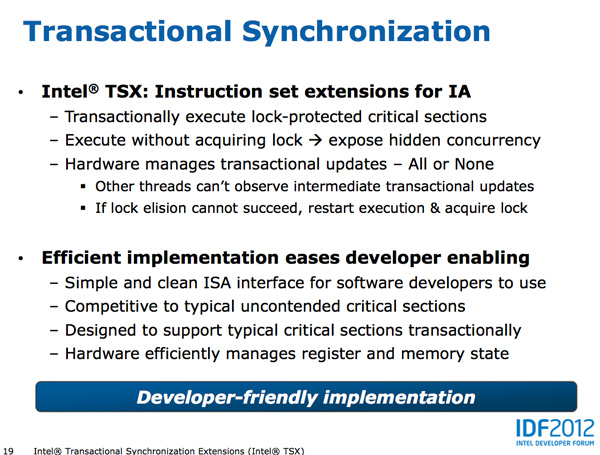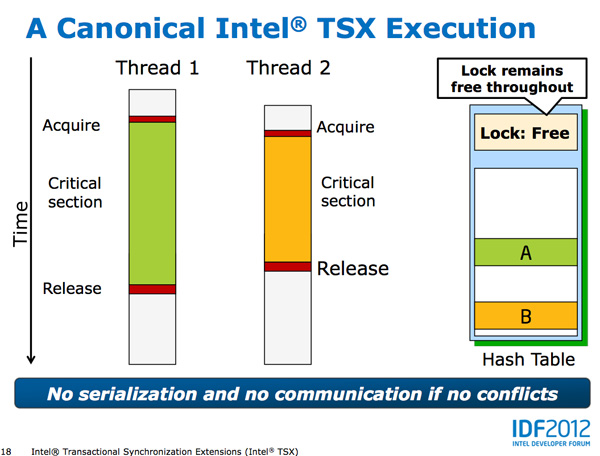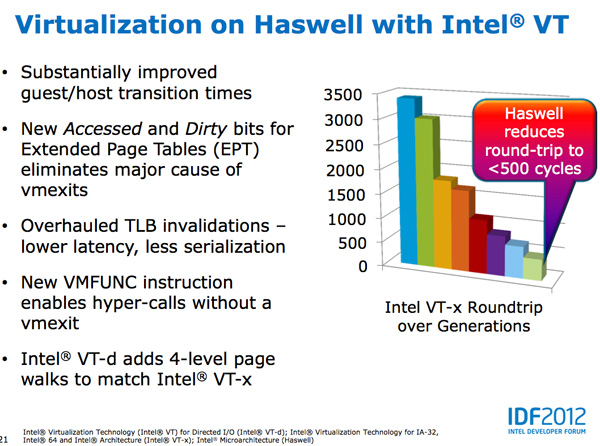Intel's Haswell Architecture Analyzed: Building a New PC and a New Intel
by Anand Lal Shimpi on October 5, 2012 2:45 AM ESTTSX
Johan did a great job explaining Haswell's Transactional Synchronization eXtensions (TSX), so I won't go into as much depth here. The basic premise is simple, although the implementation is quite complex.
It's easy to demand well threaded applications from software vendors, but actually implementing code that scales well across unlimited threads isn't easy. Parallelizing truly independent tasks is the low hanging fruit, but it's the tasks that all access the same data structure that can create problems. With multiple cores accessing the same data structure, running independent of one another, there's the risk of two different cores writing to the same part of the same structure. Only one set of data can be right, but dealing with this concurrent access problem can get hairy.
The simplest way to deal with it is simply to lock the entire data structure as soon as one core starts accessing it and only allow that one core write access until it's done. Other cores are given access to the data structure, but serially, not in parallel to avoid any data integrity issues.
This is by far the easiest way to deal with the problem of multiple threads accessing the same data structure, however it also prevents any performance scaling across multiple threads/cores. As focused as Intel is on increasing single threaded performance, a lot of die area goes wasted if applications don't scale well with more cores.
Software developers can instead choose to implement more fine grained locking of data structures, however doing so obviously increases the complexity of their code.
Haswell's TSX instructions allow the developer to shift much of the complexity of managing locks to the CPU. Using the new Hardware Lock Elision and its XAQUIRE/XRELEASE instructions, Haswell developers can mark a section of code for transactional execution. Haswell will then execute the code as if no hardware locks were in place and if it completes without issues the CPU will commit all writes to memory and enjoy the performance benefits. If two or more threads attempt to write to the same area in memory, the process is aborted and code re-executed traditionally with locks. The XAQUIRE/XRELEASE instructions decode to no-ops on earlier architectures so backwards compatibility isn't a problem.
Like most new instructions, it's going to take a while for Haswell's TSX to take off as we'll need to see significant adoption of Haswell platforms as well as developers embracing the new instructions. TSX does stand to show improvements in performance anywhere from client to server performance if implemented however, this is definitely one to watch for and be excited about.
Haswell also continues improvements in virtualization performance, including big decreases to guest/host transition times.














245 Comments
View All Comments
lmcd - Saturday, October 6, 2012 - link
Interestingly, this might be the first chance in forever AMD has at competing with Intel. If Haswell's sole goal is to hit lower power targets, and Piledriver hits its 15% and Steamroller its 15% over that, AMD is suddenly right up with Intel's i5 series with its GPU-less chips, and upper i3-range with their APUs, which is absolutely perfect positioning: most i5 purchases are for people planning to pair with discrete graphics, while most i3 series seem to go to the PC buyer looking for low price tags.The one downside is that the i7 series is Intel's money-maker: the clueless people who think they're getting maximum performance but are really just feeding the binning system and buying an unbalanced PC.
milkod2001 - Sunday, October 7, 2012 - link
u got it wrong bro, Intels money maker is not i7, it's i3 and i5(low end and a bit of mainstreem)as for Haswell, on paper it looks too good to be true as Ivy did last year and ended up everything but impressive.
Since Intel conroe core(2006) there actually were not any significant improvements worth mentioning.There's not much extra what todays CPUs can do and Pentium4 could not a decade ago.
I would love to see some innovations user could really benefit from(something like reattachable,thin, light, portable, firm solar panel hooked at the back of screen or even build in as last layer into screen itself) and not that crap Intel/AMD gives us year by year.
xeizo - Sunday, October 7, 2012 - link
Anand is very right, it's everything about power savings which in effect makes smaller and more portable form factors possible!As for mainstream perfomance, my Linux workstation still uses a Q9450 rev. C1 from 2008 clocked at 3.2GHz and a SSD of course. That box feels in every way as snappy as my Windows-box with Sandy Bridge at 4.8GHz. Which means, I really didn't need more performance than what C2Q already gave. Of course the SB-box benchmarks much faster, about twice as fast in most things, but the point is for myself I really don't need that perfromance except for some occasional game.
But I could use a smaller, cooler running device instead!
Teknobug - Tuesday, October 16, 2012 - link
LOL my Linux system still runs a Sempron and it's still fast.oomjcv - Sunday, October 7, 2012 - link
Very interesting article, enjoyed reading it.Something I would like to see is a decent comparison between Intel's and AMD's plans. Many might be able to outline the basics, but a thorough article on the subject should be rather enlightening... Comparing their design philosophies, architectures, possible pitfalls and successes etc, pretty much what's been done with this article only with both companies.
I know it might be time consuming but I imagine it could be quite a nice read.
zwillx - Monday, January 21, 2013 - link
agreed; it's difficult to find the common ground with so many different chip architectures. x86 is a big enough competition but now it's getting split wide open with ARM and BIG/litle etc etc so it's always helpful to have either more charts or real world examples lol.My take from this article though: Haswell still won't have the prowess to beat the GT650. I have GTX660 in my laptop w/ Optimus (TM). It works. Runs a game on HD4000 at 17 FPS. On the GTX660 I get 100+ fps, and am able to use higher anti-aliasing settings. So, clearly a 100% improvement over Ivy bridge is only putting the chip into "mediocre" category by the time its released.
alexandrio - Sunday, October 7, 2012 - link
"The bigger concern is whether or not the OEMs and ISVs will do their best to really take advantage of what Haswell offers. I know one will, but will the rest?"I am curious who is that one OME that will do their best to really take advantage of Haswell offers?
zwillx - Monday, January 21, 2013 - link
Apple. Or are you joking. I personally hate Apple and have since the original iMac but their engineering is top notch when it comes to getting ideal performance from silicon to user. So.. guessing that's the reference.Silma - Monday, October 8, 2012 - link
A fine read, technically very comprehensive, but still overly melodramatic.While it is true that it is crucial for Intel to step a foot in the byod market some things still hold true:
- In value and profit the PC processor market is much bigger than the byod processor market and will stay so for years because PCs, especially business PCs won't disappear anytime soon.
- Nobody can touch Intel in this market, it has been proved for decades. Not AMD at the height of its success, not mighty IBM, not Sun, nobody.
- Contrary to what you say Intel has a definitive production advantage and there are very few fabs able to compete. Note that Apple is incapable of producing processors, it is dependent on external manufacturers.
- What Apple does with its processor is interesting business wise for its iPods/Pads/Phones, but Apple doesn't have the research power Intel and others have in the chip space and I can't see how it will innovate better than Intel and other competitors.
- Intel is aware of its shortcomings, is pushing tremendously in the right direction. A competitor that doesn't rest on its laurels is a mighty threat, ARM beware.
- If Apple stops using Intel processors, it will of course wipe a few hundred millions of Intel's turnover but won't be anything remotely dangerous for Intel
- It remains to be seen that Apple users will accept yet another platform change.
- It remains to be seen that it would make sense business-wise for Apple
- I am quite sure many phone companies will be open about renewed chip competition and not letting a single platform become too powerful.
All in all it seems to me Intel is as dangerous as ever, executing very well in its core business and heading towards great things in the phone/pad space.
johnsmith9875 - Thursday, October 11, 2012 - link
Why couldn't they at least stick to LGA2011?